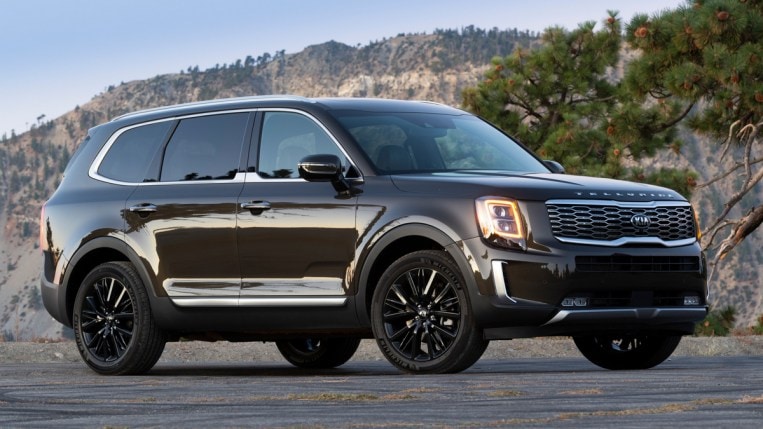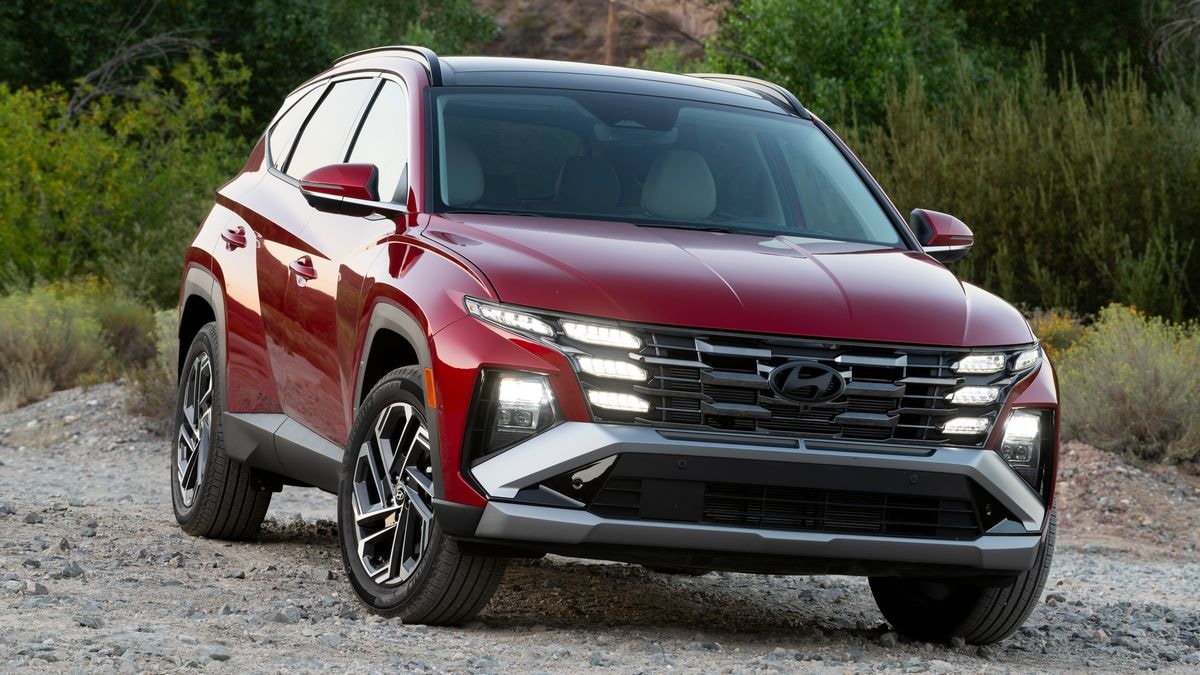Quick Facts About Daytime Running Lights
- The U.S. government doesn’t require daytime running lights on passenger vehicles.
- You can’t manually turn daytime running lights on and off.
- Daytime running lights can make your car easier to see by other motorists in low-light situations like cloudy days.
Which came first, the chicken or the egg? We may never know the answer to this question, but there are others to address — such as whether you really need daytime running lights on your vehicle. We’re a little more confident with the DRL question than that of the chicken or the egg, so we’ll take a crack at it.
Some governments believe that daytime running lights prevent accidents and have mandated their use on motor vehicles. These are mostly governments huddled together in northern climates, wishing the sun would come out. For example, Sweden, Finland, Norway, and Canada mandated daytime running lights decades ago. However, the European Union also required them on most new motor vehicles by 2012.
So far, the United States government has declined to take up the cause of daytime running lights, citing a lack of meaningful studies indicating daytime running lights reduce accidents or save lives. It’s much simpler to define daytime running lights than to make a case for why you need them. So, let’s begin there. We’ve provided links below if you want to skip ahead.
- What Are Daytime Running Lights?
- How Do You Use Daytime Running Lights?
- Can You Add Daytime Running Lights to a Car?
- Do You Need Daytime Running Lights?
- What Is the Future of Daytime Running Lights?
- Our Take
What Are Daytime Running Lights?
Despite the government’s lack of action, most new passenger cars, SUVs, and light trucks sold in the U.S. have daytime running lights. You may also hear them referred to as “signature lights.” These low-wattage white lights automatically activate when you engage the vehicle’s ignition. Often located around the headlights, daytime running lights are found on the front fascia near the sides of the vehicle.

Daytime running lights are the Baby Bear of front lights. That is, they are not too bright and not too dim. They’re just right to illuminate a car’s front, somewhere in between parking lights and low-beam headlights.
What Is the Purpose of Daytime Running Lights?
The purpose of daytime running lights is not to illuminate the view in front of your car. Instead, they make your car more visible to the drivers and pedestrians you’re approaching. Consequently, they point forward rather than downward as headlights and fog lights do.
Daytime running lights perform most effectively when the ambient sunlight is dim — dusk, twilight, cloudy days, and so forth. That’s the primary reason Scandinavian countries, with notoriously short days, were eager to mandate them.

An unintended benefit (at least for carmakers) of daytime running lights is that they are another avenue for branding. That’s where the term “signature lights” comes into play. Audi pioneered creating a distinctive DRL pattern for most of its lineup. Moreover, daytime running lights give your car or truck a more technical and expensive look.
How Do You Use Daytime Running Lights?
There’s not much of a learning curve needed here. Daytime running lights operate all on their own. They illuminate when you engage the ignition and extinguish when the headlights activate. The driver has no real control over operating DRLs because there is no daytime running lights on-off switch.

Under limited conditions, like when parked with the engine running, your vehicle may provide a method for extinguishing the daytime running lights. However, the procedures vary from model to model.
Can I Turn Off the Daytime Running Lights?
Although DRLs aren’t required by law, it’s rare to be able to turn them off. The daytime running lights turn on when you start the vehicle and turn off only when you turn off the vehicle. Only some carmakers provide a DRL OFF switch in select models, like Volkswagen, Subaru, and Toyota. According to Toyota, certain models, like the 2000 Toyota 4Runner, 1999-2000 Toyota Camry, and 1999-2000 Toyota Corolla come with a “DRL OFF” setting on the headlight control knob.
Can You Add Daytime Running Lights to a Car?
Yes, you can add daytime running lights to your vehicle if it doesn’t have them. We don’t recommend you do the job yourself unless you’re an experienced do-it-yourselfer. Although installing a universal daytime running lights system isn’t brain surgery and can be accomplished in an afternoon, it is your car’s electrical system, after all. Any misstep can have a negative ripple effect throughout the electrical system. Moreover, the installation must follow specific regulations for the location and direction of DRLs, whether by you or a professional installer.
If you do choose to perform the work, there are dozens of DRL aftermarket kits to consider. We suggest a universal kit adaptable to just about any car, truck, or SUV.
How Much Does a Daytime Running Lights Kit Cost?
Do-it-yourself DRL kits are available online and from some brick-and-mortar retailers. Expect to pay from $50 to $200 for a universal kit.
How Much Does It Cost to Professionally Install Daytime Running Lights?
Here’s the not-so-good news. Beyond the local dealership for your vehicle’s brand, you may need to do some legwork to find a competent professional installer for your DRL kit. That’s not to say they aren’t out there, but many auto shops simply don’t have experience with the installation.
However, your search efforts can pay off. Look for custom auto shops that specialize in exterior lighting. Expect to pay about $750 in many parts of the country. That rough cost estimate would cover a $150 universal daytime running light kit and three or four hours of labor for the installation.
Do You Need Daytime Running Lights?
Now we’ll get to the question of whether you need daytime running lights. It seems intuitive that illumination on the front of a vehicle would help pedestrians and other drivers see it. However, the studies measuring their effectiveness during daylight hours are mixed. As stated above, the U.S. government doesn’t feel compelled to make them mandatory.
Pros
- Statistical Evidence — Despite the government’s claim that there isn’t enough evidence to warrant mandating DRLs, there is some evidence. A 2010 publication from the Minnesota Department of Transportation stated that DRLs reduced the number of daytime crashes from 5% to 10%. A 2008 study from the National Highway Traffic Safety Administration (NHTSA) placed the accident reduction with DRLs at 5.7% for light trucks and vans.
- Dim Ambient Light — When there is enough light that you don’t require headlights, but the light is fading, DRLs are at least somewhat effective. They can increase the likelihood of seeing an approaching vehicle, particularly a dark-colored one.
- Insurance Discounts — Some insurance companies may provide discounts to drivers with vehicles using DRLs. Such discounts may vary by state.
- They Look Cool — There’s no doubt about it: Today’s crop of DRLs adds some spark to the face of cars, trucks, and SUVs by making vehicles look more technologically advanced.
Cons
- Driver Confusion — The most common complaint about daytime running lights is that they throw out enough illumination to fool some drivers into thinking their headlights are on when they aren’t. Although approaching drivers will still see you, and you will see them, DRLs don’t do much to illuminate the road. Moreover, if your headlights aren’t engaged, neither are your taillights, creating a major safety hazard in the dark.
- Additional Fuel Consumption — Believe it or not, DRLs add to the load on the alternator, requiring burning more fuel to keep up with the power demands. This also means a bit more stress on the alternator. However, the additional gas and extra stress on the alternator are minimal and hardly worth discussing. Besides, most DRLs on today’s new cars are LEDs, requiring very little energy. By the way, heated seats and heated steering wheels also sap power from the alternator, requiring burning extra fuel.
- They Draw Away Attention from Other Things — Most motorcyclists operate their vehicles with the headlight illuminated no matter the time of day. They do this with the belief it makes them more visible to other traffic. Many of these same motorcyclists argue that the proliferation of DRLs distracts from motorcycles’ headlights, reducing their safety. Some anti-daytime running lights advocates contend that all DRLs attract too much of other drivers’ attention making it less likely they will notice pedestrians, bicyclists, and other objects on the road.
Is Operating a Vehicle Without Daytime Running Lights Illegal?
No. Because DRLs aren’t mandated by the government, it is not illegal in the U.S. to operate a vehicle with a DRL burned out or absent entirely.
What Is the Future of Daytime Running Lights?

There is no reason to think daytime running lights are going anywhere, whether the government changes its mind and mandates them or not. Carmakers are always looking for economies of scale. That is, bringing down the price of a feature by installing it in more vehicles. DRLs are already relatively cheap, even in the aftermarket. It makes sense for manufacturers to continue installing them as standard on cars they sell in the U.S. to help keep prices down in markets requiring DRLs.
Did You Know: You can check your vehicle’s Kelley Blue Book value anytime?
Our Take
We agree that DRLs probably help reduce the number of accidents in lower-light situations, such as overcast days or at dusk. However, we’re not sure that’s worth the time and expense of installing an aftermarket kit on your 10-year-old beater that doesn’t have them. On the other hand, we don’t see any real harm in having them, even if they don’t provide additional safety. Mandated or not, they are here to stay for the foreseeable future.








